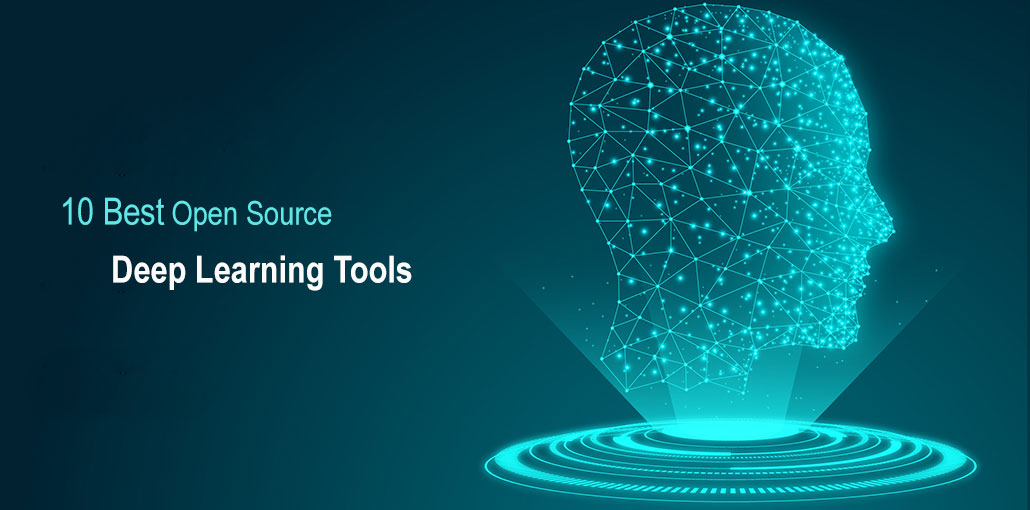Alexa playing your favorite song on your sideboard, autonomous cars driving along the roads, Netflix suggesting shows based upon what you’ve watched…deep learning has the power to change everything! This field is home to many open source deep learning tools. Let’s take a look at some of their best.
Top 10 Open Source Deep Learning Tools
1. TensorFlow
TensorFlow ( www.tensorflow.org ) is an open source deep learning framework that allows the creation of machine learning models. It was founded on November 9, 2015.
Features
- This model provides an entire end-to-end solution, from construction to deployment
- Also supports model deployment on embedded devices and mobile devices
- Documentation and support from the community are key.
- Support for multiple GPUs
- Queues and graph visualization
- Image processing, computer vision, and speech recognition are supported
Also read: A Complete Beginner’s Guide to Deep Learning with Python
2. Keras
Keras (keras.io), an open-source deep-learning library for Python, was released on March 27, 2015.
Features
- Developer guides and extensive documentation
- It is easy to use and learn
- Clear and complete error messages
- Models for mobile devices, web, and Java Virtual Machine support
- Distributed deep learning models for graphics processing units (GPUs), and tensor processor units (TPUs).
- Both in the industry and in research, this principle is widely accepted
3. PyTorch
PyTorch (pytorch.org), an open-source machine learning library, was released in September 2016. It was created by Adam Paszke and Sam Gross, Soumith Chantala, Gregory Chanan, and Gregory Chanan.
Features
- It is widely accepted on major cloud platforms for its ease of development and scalability.
- Facilitates end-to-end pipeline flow from Python development to mobile device installation (iOS or Android).
- Industry developers and active researchers provide strong ecosystem libraries that allow development in multiple domains, from reinforcement learning to computer vision.
- Direct interface to ONNX (open neural network exchange ) compatible systems and environments. Models can be exported in the ONNX standard format
- Multiple GPU support is available for deep learning models.
- C++ Interface Supports High Performance and Low Latency Applications
- Data sharing with libraries externally supported
4. OpenNN
OpenNN (www.opennn.net), is an open-source library of neural networks for machine learning and deep learning. The first version, version 0.1, was released on November 22, 2018.
Features
- It allows users to create a neural network model with no programming
- It offers a user-friendly interface for data management and interpretation of results using the neural designer tool.
- Faster training than other deep learning frameworks
- Excellent execution speed and memory allocation performance
5. Microsoft Cognitive Toolkit (CNTK)
Microsoft Cognitive Toolkit (CNTK), is a commercial-grade open-source deep learning tool. It was released in its initial release on January 25, 2016.
Features
- CNTK APIs can be accessed in Python, C#, and C++. BrainScript is also available as a model programming language.
- Java Apps supports the evaluation of the CNTK feature.
- Provides APIs of low-level and high level
- It allows you to easily combine different deep learning models such as a convolutional neural net, recurrent neural net, and deep-feed forward neural network.
- Parallelisation and autonomous differentiation across multiple GPUs and servers
- Supports the implementation of unsupervised, supervised, and reinforcement learning as well as generative adversarial networks.
6. Apache MXNet
Apache MXNet (mxnet.apache.org), an open-source deep learning framework, was released on May 26, 2016 (version 0.7.0).
Features
- This front-end provides a hybrid front-end that seamlessly transitions between Gluon anxious imperative mode and symbol mode; high speed, flexibility
- Dual parameters server and Horovod (distributed deep-learning framework) support scalable distributed training.
- Supports other languages like Scala, Julia, and Clojure.
- Computer vision, text classification, time series, natural language processing, and computer vision are all supported
7. DeepLearningKit
DeepLearningKit, an open-source deep learning framework, was developed for Apple iOS, OS X, and tvOS. For more details, visit github.com/DeepLearningKit.
Features
- This app integration and GPU acceleration was developed using Swift and Metal, respectively
- Apple devices use convolutional neural networks for image recognition
Also read: 10 Most Popular Python Libraries for Machine Learning
8. Deeplearning4J
Deeplearning4J, an open-source deep learning framework, was first released in 2014. A stable release was made available on May 13, 2020. Vyacheslav Kokorin and Josh Patterson are the main authors.
Features
- All Java virtual machine-based languages, including Scala, Clojure, and Java, are supported
- This framework allows for distributed deep learning by facilitating training in a cluster. Hadoop and Apache Spark are distributed systems that support the framework.
- A topic and vector space model have been designed to efficiently manage large text sets and natural language processing tasks.
- This includes implementation of the restricted Boltzmann device, deep belief networks, deep autoencoders, recursive neural network, stacked demonizing autoencoders, word2vec, document2vec, GloVe.
9. Darknet
Darknet is an open-source neural network framework that was first released in 2013. For more details, visit pjreddie.com/darknet/.
Features
- To provide high performance, the framework is written in C.
- Installation is quick and simple
- Compatibility with CPU and GPU computations
- Facilitates image classification, time series prediction, natural language processing, etc
10. PlaidML
PlaidML, an open-source tensor compiler for machine learning framework, was released on October 20, 2017.
Features
- Support for new GPUs, platforms, and nGraphs has been added
- Modular hardware support is available from embedded to new processors
- It works on major operating systems like Linux, macOS, and Windows










Leave a comment